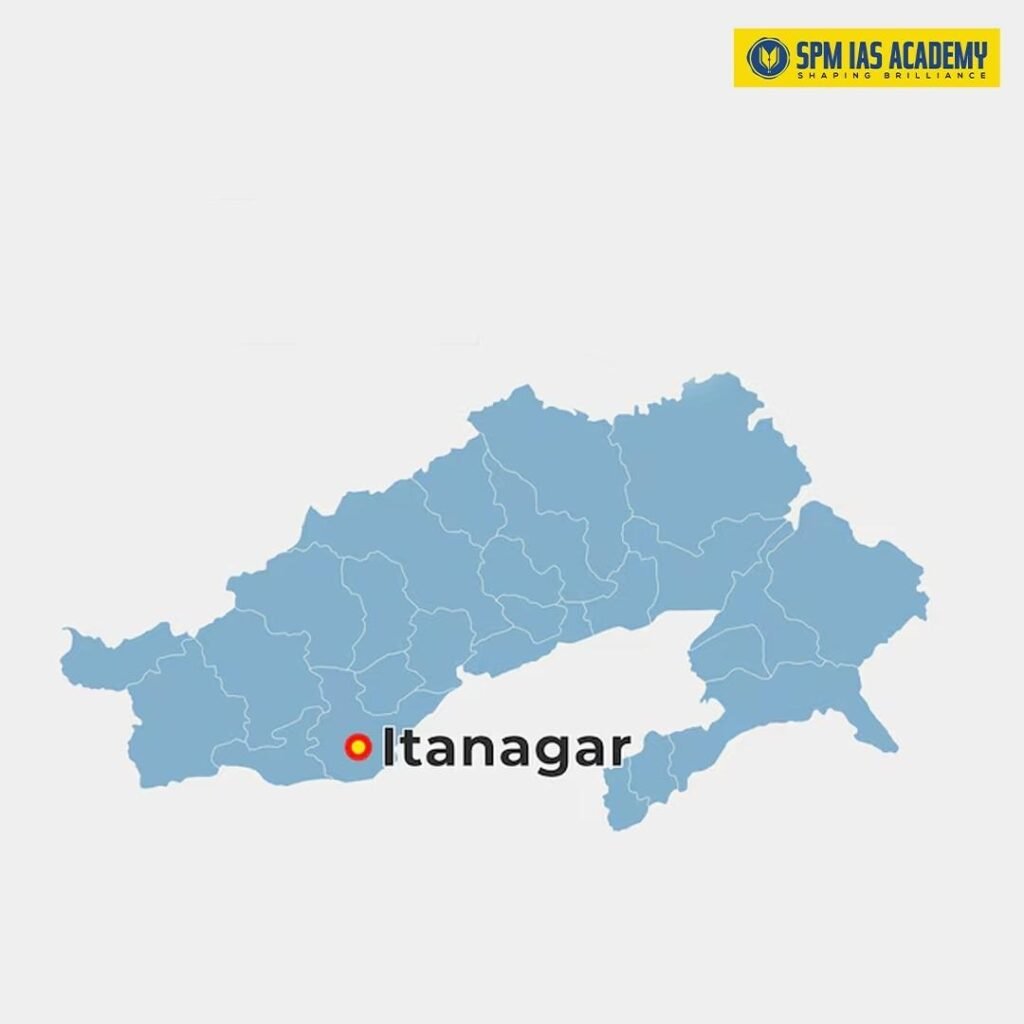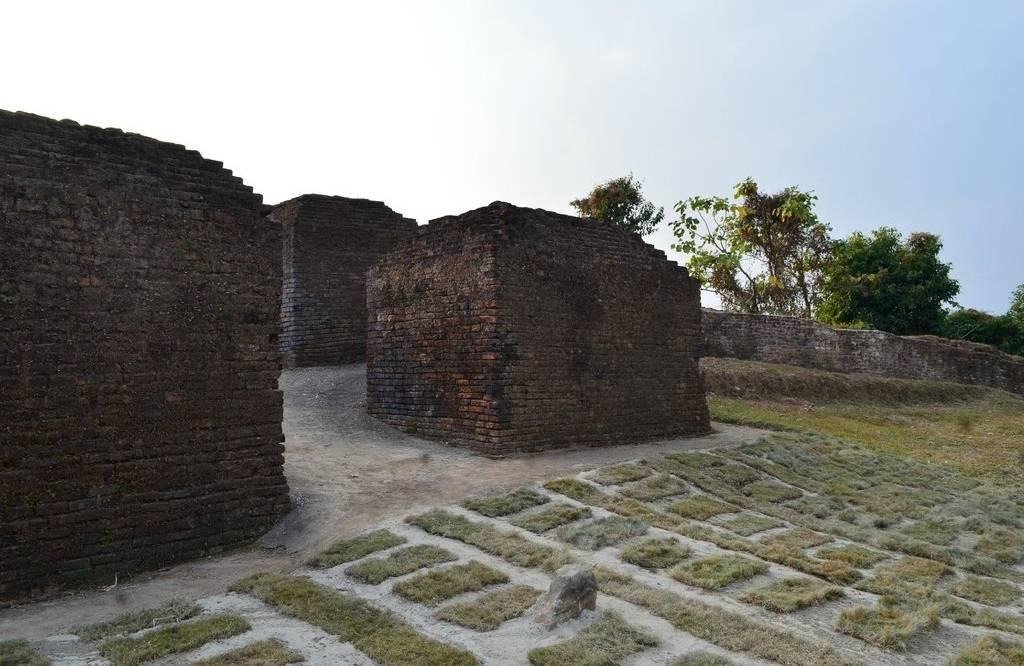Arunachal Pradesh, known as the “Land of the Rising Sun”, is India’s easternmost state. For every aspirant of UPSC, APPSC and Other Competitive Exam, knowing facts on state capitals, especially those of Northeast India is important. In this article, we will come to know about the basic facts on the capital of Arunachal Pradesh. And along with that we will learn other related facts regarding its geography, demography etc.
About Itanagar – the Capital of Arunachal Pradesh:
Itanagar, the picturesque capital of Arunachal Pradesh, is a vibrant city settled in the foothills of the Eastern Himalayas. Known for its scenic beauty, rich tribal culture, and pleasant climate, Itanagar serves as the political, cultural, and educational hub of the state. This charming hill city beautifully combines natural serenity with modern infrastructure. From ancient heritage sites like ‘Ita Fort’ to lush green landscapes and monasteries, Itanagar reflects the true spirit of Arunachal Pradesh.

- Itanagar is the capital of Arunachal Pradesh and largest town of Arunachal Pradesh. It serves as the political and administrative heart of the state.
- Moreover, it houses the Arunachal Pradesh Legislative Assembly, the state government offices, and a permanent bench of the Gauhati High Court located at Naharlagun.
- Additionally, Itanagar functions as the hub of major economic activities, forming the Itanagar Capital Complex Region together with Naharlagun.
- This region extends from the Itanagar Municipal limits at Chandranagar to Nirjuli Town, covering a key administrative and urban corridor.
- Furthermore, the Itanagar Capital Complex serves as a vibrant junction of culture, economy, fashion, education, and recreation. It reflects the city’s diverse and dynamic character.
Basic facts about the Capital of Arunachal Pradesh – Itanagar:
- Total area – 51.69 km2
- Population – 59,490 (Census 2011)
- As per Census, 2011, Nishi was the most spoken language in Itanagar. Other language spoken are Adi, Apatani, Bengali, Nepali, Assamese
Historical Background of Itanagar – the Capital of Arunachal Pradesh:

- Itanagar traces its origins to the ancient ‘Ita Fort’, built in the 14th–15th century by the Ahom rulers, which gives the city its name. ‘Ita’ meaning brick in Assamese.
- Moreover, the fort’s red-brick architecture reflects the early settlement and cultural influence of the region’s indigenous tribes and Ahom dynasty.
- During the British period, the area remained largely unexplored, but Itanagar gradually gained strategic and administrative importance due to its location near the Himalayan foothills.
- After India’s independence, the region became part of the North-East Frontier Agency (NEFA), and Itanagar emerged as a key administrative centre.
- Consequently, in 1974, Itanagar was officially declared the capital of Arunachal Pradesh, replacing Shillong, which earlier served as the administrative hub for the region.
- Since then, Itanagar has grown rapidly, becoming a symbol of Arunachal Pradesh’s political identity, heritage, and progress.
Demography of Itanagar – the Capital of Arunachal Pradesh:
- As per the 2011 Census of India, Itanagar recorded a total population of 59,490, reflecting its status as a growing urban centre in Arunachal Pradesh.
- Moreover, males accounted for 53% of the population, while females made up 47%, showing a slight gender imbalance.
- In terms of education, the city achieved an average literacy rate of 66.95%, which is lower than the national average of 74.4%.
- Additionally, male literacy stood at 73.69%, whereas female literacy was 59.57%, indicating a noticeable gender gap in education.
- Furthermore, about 15% of Itanagar’s population comprised children below 6 years of age, highlighting a young demographic profile.
Geographical Features of Itanagar:
- Situated at an altitude of around 350 meters above sea level, the city is surrounded by lush green hills, dense forests, and flowing rivers like the Senki, Dikrong and Pare.
- Itanagar enjoys a subtropical humid climate with heavy monsoon rains and pleasant winters.
- Its fertile loamy soil supports rich vegetation, including bamboo, teak, and cane.
- Known for its natural beauty and hilly terrain, Itanagar beautifully blends modern urban life with the serene charm of the Himalayas.
- Nearest Major City: Guwahati (about 330 km away)
Transportation:
- Itanagar is well connected by road, railway and air.
- On 7th April, 2014, Itanagar came on railway map of India.
- The newly inaugurated Donyi Polo Airport (2022, a greenfield airport) has significantly improved connectivity, making Itanagar easily accessible from other northeastern states and metro cities.
Administrative Importance:
- As the capital of Arunachal Pradesh, Itanagar houses the key administrative offices of the Government of Arunachal Pradesh, including:
- Raj Bhavan (Governor’s Residence)
- Arunachal Pradesh Legislative Assembly
- Civil Secretariat
- Chief Minister’s Office
- The city plays a crucial role in policy-making, governance, and development activities of the entire state.
Cultural and Educational Significance:
Itanagar is not just the Capital of Arunachal Pradesh, it is the cradle of its vibrant tribal heritage and youthful aspirations.
- Itanagar reflects the vibrant tribal culture of Arunachal Pradesh. The city celebrates various local festivals such as:
- Nyokum Yullo (Nyishi Tribe)
- Losar (Monpa Tribe)
- Solung (Adi Tribe)
- It is also an educational hub in the Northeast, home to:
- Rajiv Gandhi University (RGU) – the oldest university in the state
- North Eastern Regional Institute of Science and Technology (NERIST)
- National Institute of Technology (NIT), Arunachal Pradesh
Tourism in Itanagar:
- Itanagar attracts tourists with its mix of natural beauty, heritage sites, and tribal culture.

- Top attractions include:
- ‘Ita Fort’ – The ancient brick fort that gives the city its name.
- Ganga Lake (Gyakar Sinyi) – A serene natural lake surrounded by forests.
- Jawaharlal Nehru State Museum – Showcasing tribal art, crafts, and traditions.
- Buddhist Gompa – A peaceful monastery symbolizing Arunachal’s spiritual harmony.
- Indira Gandhi Park is a popular park in Itanagar.
- The city also serves as a gateway to destinations like Ziro Valley, Tawang, and Pasighat.
Why is Arunachal Pradesh called the ‘Land of Rising Sun’?
- Arunachal Pradesh is known as the “Land of the Rising Sun” because it is the easternmost state of India, where the sun’s rays first touch the Indian subcontinent.
- The name comes from Sanskrit, where “Aruna” means ‘sun’ and “Achal” means ‘mountain’, together meaning “land of the dawn-lit mountains.”
- Dong village in the Anjaw district is the first place in India to witness sunrise, reinforcing the state’s title.
- The phrase also symbolizes new beginnings, hope, and natural beauty, reflecting the state’s vibrant culture and pristine environment.
Strategic Importance of Arunachal Pradesh in India’s Security and Foreign Policy:
- Border Security: Shares a 1,129 km border with China. It makes it vital for India’s territorial integrity and defence preparedness.
- Geopolitical Significance: Acts as a buffer state between India and China, crucial amid on-going Sino-Indian border tensions.
- Military Presence: Hosts key Indian Army and Air Force bases, ensuring rapid response capability in the eastern sector.
- Connectivity Projects: Initiatives like the Trans-Arunachal Highway and Frontier Highway strengthen strategic mobility and border infrastructure.
- Foreign Policy Leverage: Reinforces India’s stance on sovereignty and border diplomacy, especially regarding China’s claims over the region.
Conclusion:
To summarize, Itanagar is the capital of Arunachal Pradesh, symbolizing the state’s cultural richness, administrative strength, and strategic importance in India’s northeast. For every UPSC, APSC, and State PCS aspirant, learning about Itanagar’s history, geography, and governance forms an essential part of static GK and Indian polity preparation.
Sources:
Latest Articles
| Article Title | Read More |
|---|---|
| Top 10 UNESCO World Heritage Sites in India | Read Article |
| Special Agencies of United Nations | Read Article |
| Tiger Reserves in India | Read Article |
| Neighboring Countries of India | Read Article |
| Middle East Countries | Read Article |
| Top 10 Highest Mountain Peaks in India | Read Article |
| 10 Most Powerful Countries in the World by Military Strength | Read Article |
The capital of Arunachal Pradesh is Itanagar, located in the Papum Pare district. It serves as the political, administrative, and cultural hub of the state, housing key institutions like the Arunachal Pradesh Legislative Assembly and Raj Bhavan.
Itanagar is famous for its historical ‘Ita Fort’, which dates back to the 14th–15th century and gives the city its name. The city is also known for its natural beauty, Buddhist monasteries, tribal festivals, and modern educational institutions like Rajiv Gandhi University and NERIST.
Itanagar was officially declared the capital of Arunachal Pradesh in 1974, replacing Shillong, which earlier served as the administrative centre for the region under the North-East Frontier Agency (NEFA).
Itanagar is located in the foothills of the Eastern Himalayas, at an altitude of about 350 meters above sea level. It features hilly terrain, dense forests, and rivers like the Senki and Dikrong. The city enjoys a subtropical humid climate with heavy monsoon rainfall and pleasant winters.
Itanagar is well-connected by road, rail, and air. The Donyi Polo Airport (inaugurated in 2022) provides air connectivity to major cities, while the railway line inaugurated in 2014 links Itanagar with Assam. The National Highway 415 ensures smooth road connectivity with Guwahati and other Northeastern cities.











